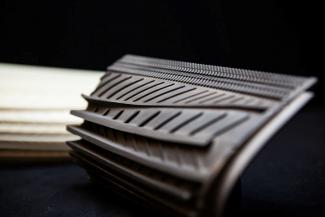A cooperative partnership with NETL is advancing the development of next-generation gas turbines to perform with greater efficiency and at higher temperatures to meet the nation’s energy needs while generating cleaner power.
Since 2011, the Steady Thermal Aero Research Turbine (START) Lab at Penn State University has progressed from a floor plan into a world-class testing facility capable of simulating realistic turbine operating conditions, thanks in large measure to support from NETL and the U.S. Department of Energy’s Office of Fossil Energy. Other main sponsors are Penn State and Pratt & Whitney, a division of United Technologies.
To generate electricity, gas turbines combust a mixture of air and fuel, such as natural gas, at high temperatures and pressures. This high-temperature and high-pressure gas is expanded through a series of nozzles and blade-like airfoils, causing the turbine shaft to spin. The spinning shaft, in turn, drives a generator that produces electricity. Gas turbines also can be used in combination with steam turbines — in a combined-cycle power plant — to create power.
Efficiency gains have been realized by increasing firing temperatures, which are now approaching 3,100 degrees Fahrenheit. However, there’s a downside to burning hotter.
During these processes, turbine blades are subjected to an extreme environment that includes high temperatures, high stresses and high vibrations. All three of these factors can lead to blade failures and corrosion. Therefore, turbine blades and other components must be carefully designed and cooled to withstand these punishing conditions.
The START Lab is developing solutions to address those issues and others. Its experimental capabilities for gas turbine research are unique because the START research turbine operates as a continuous-flow, steady-state facility that can reproduce realistic full-scale conditions. No other facility openly available for gas turbine research in the United States operates at conditions representative of modern gas turbine engines in a continuous duration mode.
One goal of the START facility is to transition new cooling technologies into working-scale gas turbines. This effort will include a series of test campaigns using blades with internal and film-cooling geometries developed by NETL and its partners.
In 2019, the project team focused on the National Experimental Turbine (NExT) initiative to help modernize the nation’s energy infrastructure. This initiative, also housed at the Penn State facility, is built upon the START turbine testing platform to advance U.S. technology, designed in collaboration with four turbine manufacturers — Honeywell, Pratt & Whitney, Solar and Siemens — in partnership with Agilis, a turbine design firm.
As part of this unprecedented level of collaboration, NExT will become a common design that can be used quickly and relatively inexpensively by these collaborating companies to advance turbines to enhanced levels of efficiency.
While most turbine geometries are highly proprietary, the goal for NExT is to provide a modern turbine design that can be used by several organizations. This collaboration will lead to higher turbine efficiency across many engine developers.
The START Lab and the NExT initiative will also develop new instrumentation and create high-fidelity analytical datasets. These datasets will support the development of computational models, machine learning and enhanced understanding of turbine performance.
Greener Energy Production
To improve gas turbine performance at higher operating temperatures, component cooling, particularly of turbine airfoils, is essential. This work supported by NETL is exploring the ability to cool gas turbine components with minimal cooling air to allow for higher operational temperatures and minimized aerodynamic losses. Results of this work not only have the potential to improve turbine operating efficiency, it will also reduce fuel requirements, lower emissions and decrease the cost of electricity.
Improvements generated by the research will yield significant environmental benefits. According to data presented at the 2019 Turbo Expo of the American Society of Mechanical Engineers, a single point improvement in U.S. turbine efficiency is the equivalent of removing two million cars from the road in terms of carbon dioxide reduction.
Improvements in gas turbine technology may also be used to develop improved engines for the defense and aviation industries, as well as to provide backup power generation for hospitals and power plants that use renewable energy sources such as solar or wind.
The START Lab at Penn State is ideally suited to conduct research that pushes the boundaries. NETL has made a worthwhile strategic investment in a research collaboration to develop tomorrow’s turbine technology to accelerate performance, efficiency and emissions reductions far beyond the capabilities of current state-of-the-art systems while strengthening U.S. energy security through use of abundant, reliable domestic energy sources rather than foreign sources.
Caption: New designs in advanced turbine blades help with cooling and improve efficiency.




